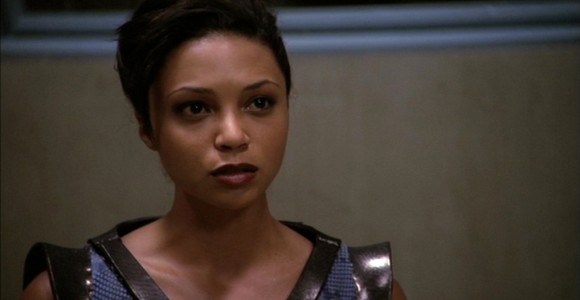Review
 EPISODE #519
EPISODE #519ORIGINAL AIR DATE: 04.26.2002
SYNDICATION AIR DATE: 04.21.2003
DVD DISC: Season 5, Disc 5
DIRECTED BY: Martin Wood
STORY BY: James Tichenor
TELEPLAY BY: Peter DeLuise
By Morjana Coffman
Season Five has been busy tying up some of the loose plot threads. In "Menace," SG-1 learns the origin of the Replicators ("Nemesis," "Small Victories," "Enemies"). They continue the exploration on the themes of artificial life forms -- and human consciousnesses stored in artificial environments -- ("Tin Man," "Double Jeopardy," "Scorched Earth," "Entity"), and the use of nanotechnology ("Brief Candle," "Learning Curve," "Absolute Power").
Granted, these themes are familiar territory. What makes "Menace" an outstanding and absorbing episode is the strong emphasis on the dynamics of friendship and the power of teamwork -- not only by the personnel of the S.G.C., but also on camera, and behind the camera, by the actors and crew of Stargate SG-1.
On camera, we were treated to some simply superb acting, marvelous directing, and outstanding special effects. Foremost was the brilliant casting of Danielle Nicolet as Reese. To heighten the mystery of Reese, we are presented with a visual dichotomy -- a robot with a child like mentality, housed in a very feminine, womanly form -- however, a very petite form, putting a subtle emphasis back on Reese appearing to be a child again.
Danielle Nicolet's powerful performance alternately intrigued me by Reese's seeming naiveté, angered me by her indifference to anyone else's welfare, and annoyed me with her petulance. (Perhaps interestingly enough, from the Merriam-Webster online dictionary, one of the definitions of "menace" is one that represents a threat or a person who causes annoyance.)
Performances by Michael Shanks (Daniel Jackson) and Richard Dean Anderson (Jack O'Neill) were solid, deeply rooted in each character's basic traits, and their deep understanding of each other. As mentioned by Daniel in "Entity," Jack's first instinct is to protect, whereas Daniel's first instinct is to communicate. It is Jack's nature to think in absolutes -- good or bad, right or wrong, safe or dangerous. It is Daniel's nature to think in the abstract, he is able to see the shades of grey, or read between the lines. Daniel has more respect for other cultures, beliefs and ideas. Daniel is the diplomat that Jack is not.
In those final seconds before Jack enters the Gate room, his main concern is containing the Replicators and maintaining the security of the S.G.C. -- and the planet. Carter had just advised him that the Replicators were possibly acting on their own and that Daniel was likely in trouble in the Gate Room with Reese.
Then Teal'c calls out for O'Neill; listen to that note in Teal'c's voice -- it's not one you'll hear often. Plus, we have the countdown continuing on the self-destruct device. Responding, Jack enters the Gate Room, and eliminates the threat -- Reese.
Daniel responds to the loss of Reese, who was possibly the key to the destruction of the Replicators battling the Asgard, by telling Jack that he is a "stupid son of a bitch." And Jack takes the comment in stride; he knows how much Daniel wanted to be able to communicate with Reese. Jack knows that Daniel is angry at the situation, at the fact there were no other choices available to them. How wonderful to see adult characters act as adults, who are friends, and yet can still have disagreements with each other without losing their respect for one another.
Among the other on-camera treats, we finally got to see our General Hammond in action. (We've seen an alternate reality Colonel Hammond in action in "There But For the Grace of God" and the alternate reality General Hammond in "Point of View.") And it was satisfying to see Colin Lawrence return to reprise his role as Major Warren ("Children of the Gods," "Prisoners," "Foothold"), Gary Jones as Technician Davis, and to see Tracy Westerholm again as the ubiquitous S.F.
Director Martin Wood provided us with some chilling scenes. Among them were the first Replicator crawling up from behind the toys and onto Reese's arm in the isolation room; Reese walking into the Gate Room, surrounded by her Replicator "toys"; and Reese standing on the Stargate ramp, the lights down in the Gate room, the only illumination coming from behind the Stargate.
Also fascinating was the use of the three monitors in Carter's lab, showing us the interior of the isolation room. It was interesting to watch Carter and Teal'c observing the action unfolding from three different points of view -- looking from the camera mounted above the isolation room doorway towards Reese; from the camera mounted in the isolation observation room towards the doorway; and a horizontal view of the isolation room.
Special Effects Supervisor James Tichenor (who also wrote the story) again brought to life the Replicators and highlighted the menace that they represent. It's astounding to know that the Replicators are computer-generated, and the detail it takes to create each one, their shadows, and matching their movements to either the actors or the firepower being directed at them.
It was also refreshing, for once, not to be shown the remaining time on the self-destruct device. (However, I did reset the elapsed time on my VCR, and adjusting the time to that shown on camera at several points, determined that there was about 10 seconds remaining.)
"Menace" provided some answers, yet also left us with some questions -- especially, why was SG-2 unable to contact the Asgard? If Reese holds the key to their salvation from the Replicators, could it be too late for them anyway? It was fascinating story-telling, and a prime example of why Stargate SG-1 is first-class entertainment.
Rating: * * *



